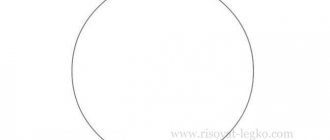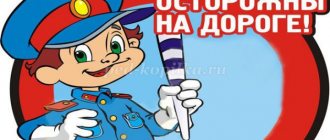Biography of Yuri Gagarin for children
Yuri Gagarin's childhood
Yuri was born on March 9, 1934 in the village of Klushino into a family of wealthy peasants. At the age of 6, the future cosmonaut went to school, but due to the outbreak of the Great Patriotic War, his studies had to be interrupted until 1943.
In 1945, Gagarin's family moved to the city of Gzhatsk. After Yuri finished 6th grade, he decided to move to Moscow. The parents tried to dissuade the young man, but were unable to do so. So, in 1949, 15-year-old Yuri Gagarin moved to the capital. He settled with relatives. He studied at a vocational school, while simultaneously completing the 7th grade program at a school for working youth.
In 1951, the young man moved to Saratov, where he began studying at an industrial technical school.
For children about space and the first cosmonaut
On April 12, our country celebrates Cosmonautics Day. On this day in 1961, our planet was shocked by the news: “Man in space!”
People's dream of flying into space has come true. But before going into space, humanity went a long way studying it.
Our Earth is a huge ball on which there are seas, rivers, mountains, deserts and forests. And also people live. Our Earth and everything that surrounds it. called the Universe, or space. In addition to our blue planet, there are others, there are 8 of them in total, and there are also stars. Stars are huge balls of light. The sun is also a star. It is located close to the Earth, so we feel its heat. We see other stars only at night, and during the day the Sun eclipses them. To compare the size of the Sun with the size of the Earth, you can take a pumpkin or watermelon and a pea. The pea is our Earth, the pumpkin is the Sun. The Earth is as much smaller than the Sun as a pea is smaller than a pumpkin.
Previously, people did not know anything about space, about the stars and believed that the sky was a cap that covered the Earth, and the stars were attached to it. Ancient people thought that the Earth was motionless, and the Sun and Moon revolved around it. Also in ancient times , people thought that the earth was flat and supported by three huge elephants. Many years later, astronomer Nicolaus Copernicus proved that the Earth and other planets revolve around the Sun. Newton understood why the planets revolve around the Sun and do not fall. They all fly around the Sun in their own way.
But in theory this is one thing, but I wanted to see it, and scientists began to develop special devices: satellites and rockets. But even after the first rockets were created, it was very dangerous to fly, because no one knew exactly what was hidden in space. And it was decided to send the animals first on the flight. There were dogs, rabbits, mice, even microbes.
Dogs are smarter animals than mice, but not all dogs were suitable for testing. Purebred dogs are very gentle, they were not suitable for space. The dogs were selected by size, trained with them, accustomed to noise and shaking. Ordinary mongrels came closest. In 1960, on August 19, two dogs, Belka and Strelka, were launched into space on the prototype of the Vostok spacecraft. They stayed in space for more than a day and returned safely. So scientists proved that space flight is possible.
Since then, a profession has appeared that did not exist before - astronaut. An astronaut is a person who tests space technology and works in space. Cosmonauts are courageous people, they train a lot, they must know and be able to do a lot in order to control a spaceship.
The first cosmonaut was Yuri Alekseevich Gagarin. On April 12, 1961, he flew into space on the Vostok-1 spacecraft and circled the Earth in 1 hour and 48 minutes. Came back alive and healthy. For our country and the whole World, Yuri Alekseevich became a hero, all newspapers and magazines wrote about him, they talked about him in all corners of the Earth. Cities, streets, and avenues are named after him. There is a crater on the Moon named after him, as well as a minor planet.
Many years have passed since the first flight, and people have learned to build complex orbital stations that are launched into space and scientists live there for several months, studying space. And on the day of the first flight into space, every year on April 12, we celebrate Cosmonautics Day - a holiday when we congratulate everyone who studies space.
For children about space and the first cosmonaut
Gagarin
Author: Ivan Slepnev
You will never grow old, Yuri Alekseevich Gagarin! Everything has passed: victories and mistakes, Your life has remained a smile to us - The highest human gratitude, A young witch’s smile. I know that your heart did not waver, You only fell silent in surprise, Maybe you felt like a space alien for a moment... The proud spirit of the pilot could not contain the tiny body of the plane, Other ships were on the shoulder!.. And when the earth slid unsteadily, Then on place of this formidable collision With a sunny Gagarin smile Suddenly a spring began to flow from the ground!...
Alexey Leonov
Pilot-cosmonaut Alexei Leonov in outer space. 1965 Photo: TASS Photo Chronicle
After five years of special training, on March 18, 1965, two more cosmonauts went into space for more than a day - Alexey Leonov (call sign “Almaz-2”) and Pavel Belyaev (“Almaz-1”).
“There is one more name that I always remember with gratitude. This name is Sergei Pavlovich Korolev. I can talk about him very long and warmly. Our whole life on the space path is connected with this person. We stood in front of our rocket, ready to enter the elevator and ascend to our ship, Voskhod 2. There were a lot of mourners. Korolev was calm and kind. At the start, time is precious. He said just a few words: “I ask for one thing.” You, Lesha, just get out of the ship and enter the ship. May the solar wind be favorable to you."
“Solar Wind” (1977), chapter “Course - Baikonur”
During the flight, Alexey Leonov went into outer space for the first time in history.
“Here is the cosmic sky. I am the first to see space with billions of stars, not from a ship, not from a porthole, but through the light filter of a spacesuit! The hatch slowly went up, the window into space opened more and more. I watched with bated breath as the star pattern quickly changed in the dark cosmic sky. Luke froze, everything was ready to go. We are approaching the Black Sea. In the headphones I hear: - Lesha, start leaving! - Got it, I'm off! “If you call yourself an astronaut, get out into space,” I thought. It was so quiet that I could hear my heart beating. I heard the sound of my breathing.”
"Going Out into Space" (1980)
As the sports commissioners recorded, he stayed “outside the ship’s cabin in outer space conditions for 23 minutes. 41 seconds,” and outside the spacecraft - 12 minutes 9 seconds. Then followed a technically difficult return - first to the ship, and then to Earth - the cosmonauts landed not in the place calculated by experts, but in the Perm taiga. Alexey Leonov described his adventures in memoirs and books for children with his own illustrations. And in 2017 he released a colorful publication “The Time of the First. My destiny is myself...”, which was filmed.
“The first words I said, stepping into the void (I don’t remember them, but they were written down): “But the Earth is round.” But in general, space is, of course, harmony. When you look at photographs of supernova explosions, the “collapse” of galaxies, taken by the Hubble telescope, this is chaos and this is scary. And when I went into space, I saw complete color harmony. Based on the colors, I clearly divided them into the colors of Rockwell Kent and Roerich. When you move from the Sun to night it is Kent, and in the opposite direction it is Roerich. There was music too. On the dark side of the Earth, where there is no interference, I could clearly hear the sound of my breathing and my heart beating. These sounds lined up into some kind of musical narrative. You can compare it with the sound of the theremin and the electronic compositions of Vyacheslav Meshcherin.”
“Time of the first. My destiny is myself..." (2017)
Tsiolkovsky
Author: N. Gribachev
I imagine these Kaluga winters, Shaggy snow and winter ice, Children on narrow sleds, A mongrel bug at the gate And that porch, that quiet house And that table on shabby paws, Where time melted, as if in a crucible, And the cosmos moved closer together. The airplane also looked like In those deaf times It was like a pterodactyl without skin, Like a whatnot with a pair of wings, And the steep-headed Kaluga resident, Blowing out the light in the seven-line, Through the ancient ceiling of Europe Already flew to the family of planets, Already, having forgotten the fate of grievances, To the witchcraft tune of winter Calculated everything night of orbit, So that we do not wander in the sky. And, hearing the roar of a jet, the meteorite whistle of rockets, I see an unpretentious house, Seven-line sleepy light, Papers, lampshades of shadow, That whole house, that whole city, Where the Russian genius began His dazzling flight.
Gagarin said “let’s go”
Author unknown
Gagarin said “let’s go” and the rocket flew into space. This was a risky guy! Since then the era began. The era of wanderings and discoveries, Progress, peace and work, Hopes, desires and events, Now all this is forever. The days will come when whoever wants to will be able to roam space! At least to the moon, please, travel! Nobody can ban! This is how life will be! But let us still remember that someone was the first to fly... Major Gagarin, a modest guy, he managed to open an era.
The first cosmonauts
The story of space exploration begins with dogs. After the launch of the satellite, the dog Laika flew into space. Unfortunately, due to problems in the life support system, Laika died.
In 1960, the flight of Belka and Strelka lasted 25 hours. It was the first spacecraft carrying living beings to return to Earth. They created special costumes for dogs, developed a diet and a machine for dispensing food. For the first time, there was a television camera on board, a new life support system, and a catapult for emergency rescue of astronauts. A search and rescue service was organized.
After the flight, the dogs lived a long life at the Institute of Aerospace Medicine.
Rice. 1. Belka and Strelka in space.
The data obtained during the flights of astronaut dogs laid the foundation for human space flights.
Cosmonauts Holiday
Author: Natalie Samoniy
Both boys and girls, In reality and in good dreams, Everyone dreams about space, About distant skies.
Today is the holiday of astronauts! – Congratulations on this day. Gagarin discovered it for us. Much has been said about him: He is the first cosmonaut in the world, Therefore he is a hero to everyone. He was the kindest person, He had an unearthly smile. That is why this holiday has become good for children, Because, apparently, everyone in childhood thought about space: All the boys want to be like Gagarin, In honor of him, children draw Multi-colored starfall. In honor of Gagarin - avenues, ships and boats... Nowadays it is a holiday for astronauts: Cosmonautics - “Hurray!”
Andriyan Nikolaev
Cosmonaut Andriyan Nikolaev during training in a centrifuge. Still from Nikolai Makarov’s documentary “10 Years of the Space Age” (1968)
In four days (August 11–15, 1962) on the Voskhod-3 spacecraft, Andriyan Nikolaev made 64 orbits around the Earth - this was the first multi-day flight in history.
“The elevator takes me to the top of the rocket launcher. I take a seat in the ship and begin checking the onboard equipment. I'm reporting to the command post. I hear Gagarin’s voice: “Andryukha, no fluff or feather!” - To hell! There is a minute left before the start. A living trembling began to run through the powerful body of the rocket. The power plants thundered. The rocket takes me high off the ground. As the speed increases, the overload becomes more noticeable. A weight falls on your shoulders, on your whole body.”
“The gravity of the earth. Notes of an astronaut - 3" (1999), chapter "64 orbits around the Earth"
The second time, together with cosmonaut Vitaly Sevastyanov, he stayed in the vastness of the Universe even longer - almost 425 hours, from June 1 to June 19, 1970. The ship circled the Earth 286 times. This was the first flight in the history of astronautics during which people worked in orbit without spacesuits.
“A ship is flying in the blackness of space. The cabin is bright. And in the portholes there is darkness. Only the young moon in the sky and the stars lazily speak to each other in a mysterious language unknown to earthlings. But we have no time for the stars now. Our work begins. And then the ship came out of the shadows onto the bright side of the Earth. This was my second time in orbit and I saw the sunrise more calmly. And Vitaly is new to space. And he perceived the first cosmic dawn very enthusiastically. “Andrey,” he exclaimed, taking me by the hand, “look, wow, what a dawn on the right, an amazing dawn! Look, what a sun... It's coming right at me! The sun is blowing right on me! The beauty is incredible!” I understood his delight, but I still told Vitaly: “We’ll still have time to admire it - there will be so much dawn ahead! Now let’s get to work!”
“Space is a road without end” (1974), part II, chapter “In orbit”
Man in space
The first person to see the Earth from space was military pilot Yuri Gagarin. His flight lasted less than 2 hours, but preparation for it took a whole year. His backup was German Titov, cosmonaut No. 2. The photograph of the first cosmonaut spread all over the world, and he was greeted with delight in many countries.
A year later, April 12 was declared Cosmonautics Day in the USSR; since 2011, this day has become international. The Gagarin Cosmonaut Training Center is located in Star City.
Rice. 2. Yuri Gagarin in a spaceship.
Today, more than 560 people from 35 countries have been in space. Astronauts work on the International Space Station (ISS), shifts last up to 8–9 months.
Gagarin and several other pilots from the cosmonaut corps participated in the development of the unmanned space shuttle Buran, which took off in 1988.





